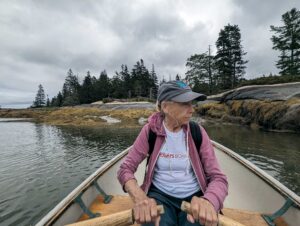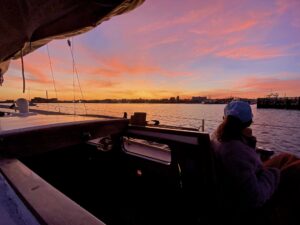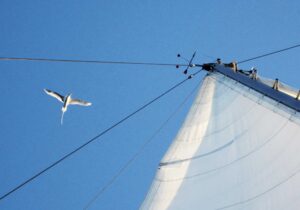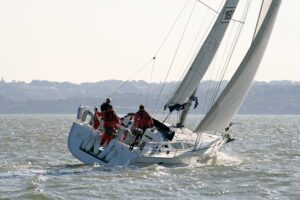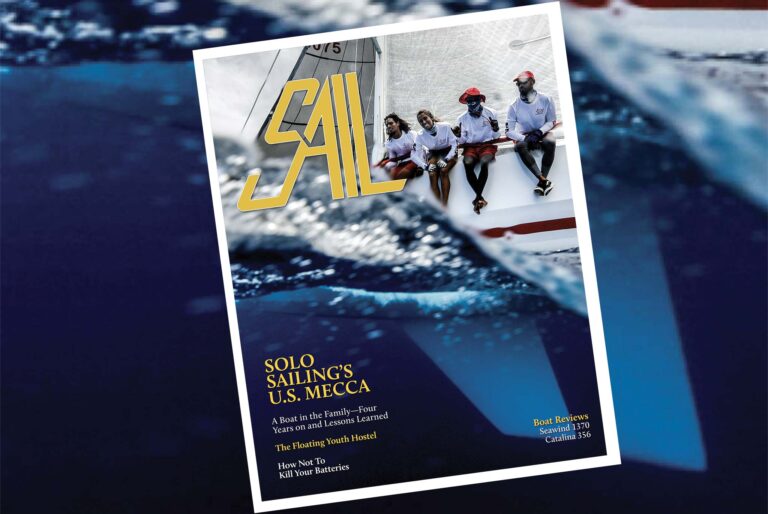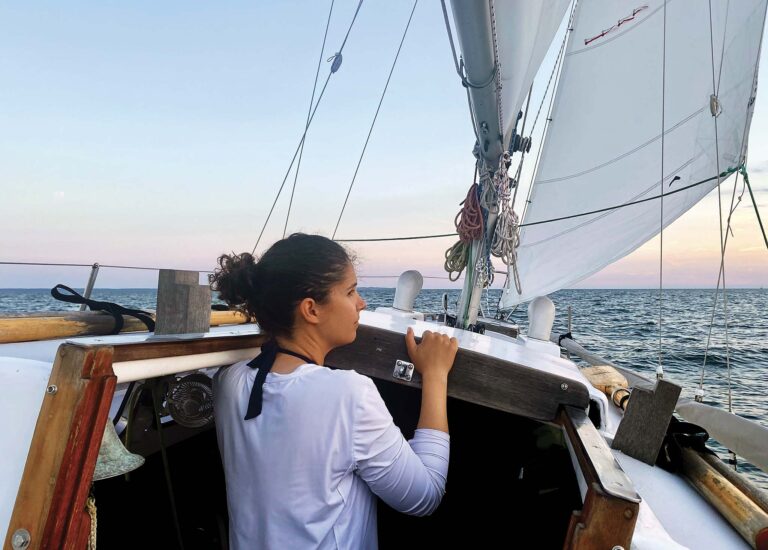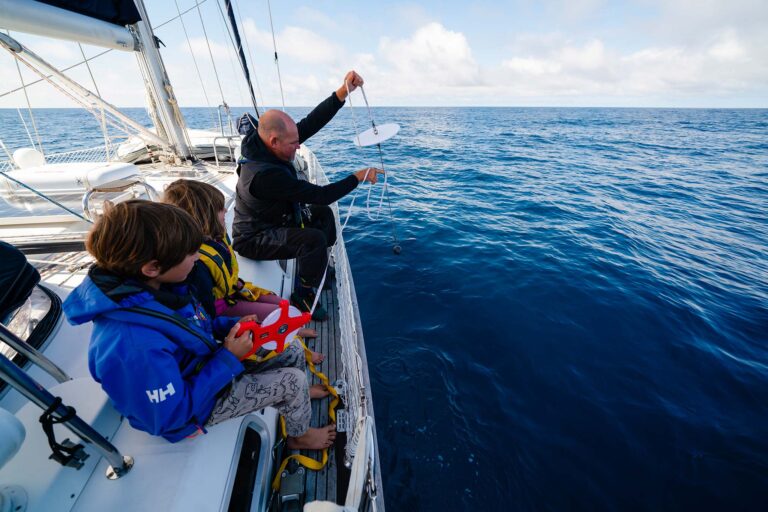When our friend Thor asked my husband, Michael, and me to cruise aboard his Presto 30, Thorfinn, for a week around the Florida Keys and Florida Bay, we jokingly told him we’d “think about it.” In fact, we’d been hoping to cruise aboard the boat with Thor and his mate, Austin, ever since we’d heard about her.
Soon afterward, with Thorfinn on its trailer, we left our home near St. Augustine, Florida, and took off at 60 mph for Marathon Key, where we launched the boat. Sailing north into Everglades National Park, we soon left all evidence of civilization behind. The Seven Mile Bridge disappeared, and the grey-green water became shallower. Once in a while Thorfinn’s rudder and centerboard kicked up. She can sail in just a foot of water, so we didn’t hesitate to steer for undeveloped shores. I breathed deeply, watching a frigate bird soaring overhead, then a dolphin playing at our bow. This area is a wonderland for those of us who still need to spend time in the wilderness to feel alive.
Late in the afternoon, we anchored stern-to off the beach at Cape Sable in the Everglades where we rendezvoused with some of Thor’s buddies who were sailing a pair of ketch-rigged Outward Bound 30 sharpies. Like the Presto 30, these boats were designed by Rodger Martin and share similar lines. We felt right at home with these fellow shoal-draft sailors.
As night fell, we sat around the fire, watched the stars, and listened to the lapping waves. I woke up when a puff of wind rocked the boat and went out on deck to enjoy the darkness. I don’t know whether people who like darkness choose to sail or if sailing allows us to experience the darkness we love. Darkness and quiet: at Cape Sable, we had both.
The next morning, the main and mizzen pulled us along through muddy green water of uncertain depth. I am accustomed to the clear waters of the Bahamas, so the opacity of the water made me uneasy. It wouldn’t have done any real harm to run aground, but we were sailing at over 6 knots, and it was unsettling not knowing when it might happen. Michael and I are accustomed to running aground, usually on purpose, so we eventually stopped worrying about it. Nonetheless when Thor, who was watching the GPS for a deeper channel—even if it was only three feet deep—told me to head away from the coast, I did so immediately.
Since we were “only” doing 6 knots, Thor and Austin went forward to set the mizzen staysail. Michael then sheeted it in and Thorfinn surged forward. Sailing at 8 knots, her wake looked substantial. At 10, it was like the wake from a powerboat. I glanced at Michael, wide-eyed. We’ve cruised shoal-draft boats for 30 years and had never sailed this fast.
A straw hat peeked from behind the foremast where Austin was looking for the entrance to the Little Shark River. A gap appeared in the mangroves ahead, followed by a channel marker, and we knew we were on track. I felt both relieved and a little let down. My sense of discovery diminished as each buoy appeared—although this was still wild country. “Keep ahold of the mast. There are gators ahead, and water moccasins hanging from limbs,” Michael warned Austin, who was still up in the bow.
Threading our way through the mangroves, we skimmed past fishermen, houseboats with tents pitched on deck and squawking egrets. Balanced on deck, I swiveled my head to watch for creatures to either side. Anhingas and cormorants dried their wings in the trees, ospreys took off from their nests, a turtle submerged under the hull and a kingfisher swooped across the river. There were pelicans, turkey vultures, white ibis and little blue herons. The river was alive.
Coming around a corner into Oyster Bay, Thor asked for a turn to port, and I was happy to oblige. Soon we had left the channel with its navigation buoys behind and were once again off the chart doing some true backcountry sailing.
The best part about this kind of sailing is that you don’t have to follow any other boats. The only other vessels we were likely to see in this narrow channel were kayaks, and even that was unlikely. We truly had the waterway to ourselves. Islands split the water into a maze of channels that have played host to many nefarious activities, from rum-running to gator poaching to drug trafficking. Not until we reached Ponce de Leon Bay in the Gulf did we see another boat. A couple of fishermen stopped to show us their catch. Proudly holding up a big black grouper, one drawled that he “growed up in these parts and been fishin’ here since I’s a kid.” I was right at home, drawling back, “Y’all got a mess a’fish.” Michael and I agreed long ago to cruise only where local folk welcomed us.
In the early evening, the wind died and we drifted northward. Thor served his famous nuclear stew—cans of chopped clams, corn and mushroom soup mixed with cilantro, pepper and garlic—and we all agreed we’d never enjoyed anything quite like it before. Stretched out in the cockpit, watching the sun set over the Gulf, we started swapping stories. Thor told us about the time he was caught in a lightning storm on an island in Maine; Michael and I countered with the time we were held up by pirates. Still, for all the thrills we face in our wanderings, and the fun that lies in the telling of tales, I was reminded that the best parts of sailing are far more mundane—sailing through a twisted mangrove river, walking on a shell beach, dodging a flock of terns, dining in a cockpit and watching the setting sun splash color across the water.
As darkness fell, Thor started the engine and showed me the course to Pavilion Key on his GPS. I nodded and pretended I would use it. But after he went below, I looked up ahead at the sky, found Cassiopeia, and used that as my guide instead. I can remember when GPS replaced our sextant, but I never dreamed it would replace the compass. It always comes as a comfort to me that the stars are still shining, right where they’ve always been.
As we anchored off Pavilion Key, I could see an orange glow lighting up the sky to the northeast. Miami, I figured, as I made my way to the V-berth. I crawled into bed, snuggled up to Michael and soon afterward heard Thor and Austin lie down in the settee berths. We all began snoring loudly.
The next day we visited Everglades City, where the annual Seafood Festival was in full swing. Having enjoyed a bit of wilderness, I was ready for a swig of urban levity—it was time for some honky-tonk fun. The four of us wandered among the revelers, watching kids riding bucking sharks, tattooed bikers swilling beer and stage musicians tuning up, their music overpowering the sound of birds crying overhead. Eventually Michael and I wandered off to watch fishermen coming back from the Gulf with their catch of the day. In the waning light, men in yellow slickers unloaded crab traps onto old wooden docks. It was dark by the time we got back to the boat.
The following morning, after we’d pulled the boat up on the beach at Panther Key to repair a chafed line, I thought about those fishermen. Michael and I have been fishing and hanging out with fishermen for years, and I’ve watched conch and crawfish and grouper disappear from areas where they once thrived. “We used to walk right out and pick up all the conch we needed,” I heard one voice say. “I used to go out at night with grains and stob up all the crawfish right off the reef,” said another. Will wild seafood go the way of the compass? Thor’s voice interupted my thoughts to remind me that I was documenting a repair. Michael was holding the rudder while Thor replaced the downhaul line. I was snapping pictures, attempting to make it look valiant. Too bad everyone looked so calm and nonchalant.
Before sunset, Michael and I took a swim and then climbed aboard Thorfinn, now re-anchored farther offshore. As the sun set, we watched red and purple light pour across the clouds and onto the sea. We were exactly where we wanted to be.
That evening we were blessed with another calm, but by late morning the following day we were doing 10 knots before a 20-knot breeze. Sailing conditions had been so unnaturally favorable I was feeling a little enchanted. The southerly wind ushered us northward, around the maze of shoals surrounding Cape Romano. As Thor tracked our progress on the GPS, Michael and I looked around at the choppy sea.
“The Guajira,” I said, imagining that Michael was also flashing back to our horror-sail along the coast of Colombia.
“Just what I was thinking,” he nodded, “But safer. No pirates, no crazed army troops.”
“Yeah, give me gales, gators and water moccasins over scary people any day.”
That night a cold front blew through with driving rain, cold temperatures and a windshift to the north. Thor was awake most of the night and in the morning greeted us with: “We’re outta here!” We didn’t even wait to make coffee, but shot out of the harbor, turned south and careened past more mangrove rivers toward Cape Romano.
By the time we reached Big Marco inlet, the whitecaps were already making the approach appear impossible. As Michael steered for the entrance, I looked astern and saw nothing but grey-green water; not even a fishing boat was attempting the pass. Thor gestured to port, Michael pushed the tiller to starboard, and wordlessly, we passed into the protected waters behind Marco Island.
My arms were brown, coated with salt. My windblown hair caught at the edge of my mouth, and my mind was full of images of mangroves, herons and sea-filled horizons. We were having fun. We were at play. And we were all the richer for it.
Photos by Ida Little

